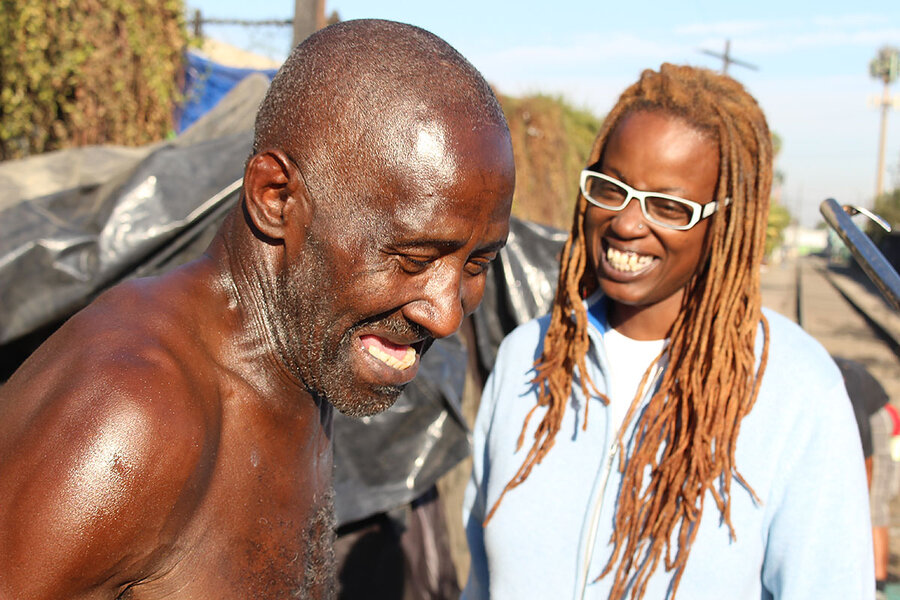Speaking of America: 'I'm a person of hope'
Loading...
| Los Angeles
The Blue Team is ready to roll.
Audrey Pearson hops in the front seat of a white van emblazoned with the Homeless Outreach sign. The vehicle exits through barbed wire that rings a former bread factory, and onto the hot and hostile streets of South Los Angeles. Charles Cuadro, a stocky man, all lip rings and necklaces, maintains a calm demeanor behind the wheel.
In the back is Ms. King – everybody calls her that, though her full name is Shanadral King – the veteran. She fled a desk job to get out back on the street, where she talks the language of the homeless. She is a presence: big bejeweled sunglasses under a halo of purple-tinted hair.
These social workers are the front lines of a nonprofit hired by the city to battle the most stubborn and accusing urban ill: the destitute people discarded to the streets, living under canvas tarps or piles of trash without food or sanitation.
Ms. Pearson is pumped. She is new on the job, a recent arrival from St. Louis with solid experience there and a psychology degree. She came to Los Angeles three months earlier “to follow my dream” – nothing to do with stardom or fame, but to work with homeless people.
In a cross-country reporting journey to sample views of America, it is good to start with Pearson. She is incurably upbeat, full of laughter and smiles. She knows the jargon of social work, but her soul just runs friendly. She dawdles to talk to everyone, from her colleagues at the Homeless Outreach Program Integrated Care System (she has to bend her neck to read the name from the HOPICS logo she now wears), to the grizzled guy emerging shirtless from under a tattered tent.
“It’s important to do what you can,” says Pearson. She started a program for lesbian, gay, bisexual, and transgender people in St. Louis, and watched it grow over six years to a charity for all homeless people, with 125 volunteers. “You have to give back how you can. We are all an inspiration to someone. Powerful things can happen.”
And yet …
Pearson was left agape by the homeless situation in L.A. “I’ve just never seen anything like it. Along all the roads and highways, all the tents. In St. Louis, the police never, never would have let this happen. They would have forced them out.
“I went to Skid Row. I thought ‘How does this happen? How do we allow this to get this way?’ We really have to ask ourselves: As a country, how do we sleep with this epidemic happening?”
Los Angeles has an estimated 58,000 homeless people, more than any US city except New York. The vagrants have taken over downtown streets, haunt Hollywood, and carve rough encampments into city parks. They lack basic hygiene; the city is alarmed at a statewide outbreak of hepatitis A, spread by contact with human waste. A cooking fire at a homeless camp is blamed for one of the flash fires that encircled the city in December.
The problem is not fed by a lack of good will. Impressively, the voters of Los Angeles have approved $1.2 billion in bonds for more housing and voted to raise the sales tax to expand social services for the homeless. The mayor and city council are on board. John Helyar, who runs the South Los Angeles outreach for HOPICS, is plowing through applications – he values time in prison or homelessness, hard to find on most résumés – to put more teams on the road.
He is hopeful, but the homeless numbers keep going up. “Clearly people want to see results,” he says. “But it’s not going to happen as soon as they think. It’s not a ‘this year’ solution.”
Pearson, too, wonders at the end-game. The social workers wrestle with a real-life puzzle to get homeless people – who often don’t want the help – into a labyrinth of services that often don’t have the space to give the help.
Mr. Cuadro pulls the van over at a jumble of tents propped against the concrete wall of I-110 at the dead end, ironically, of Hope Street. Ms. King and Pearson walk the row, greeting men and women emerging sleepily. A regular here, Dee has agreed to go to a sobriety tank, but is getting edgy about it. Eugene pulls up on a bike. He’s friendly, but wants nothing to do with their services: “I’m on the run,” he explains. “Mr. Bless” sits on a child’s trampoline and mumbles that he was evicted from a veterans’ shelter.
The Blue Team will go back to their office to work the phones to find services, but two weeks later, those three will still be on the streets. With no other anchors, many homeless people have staked claims to drugs or booze or inner demons that make the independence of their lives addictive.
“Some days, it does discourage me,” Pearson admits. “I’m a person of hope. And I know there is so much chaos going on right now, from the White House to individuals’ homes. But it makes me feel like, is this is the survival of the fittest?
“It’s time to stop stepping over our issues our problems, and even ignoring that others around us may need a helping hand to get up,” she says. “Stepping over an individual just to get in your home and ignoring the fact that they are laying down there? It has grown to be a sore that is everybody’s.”







